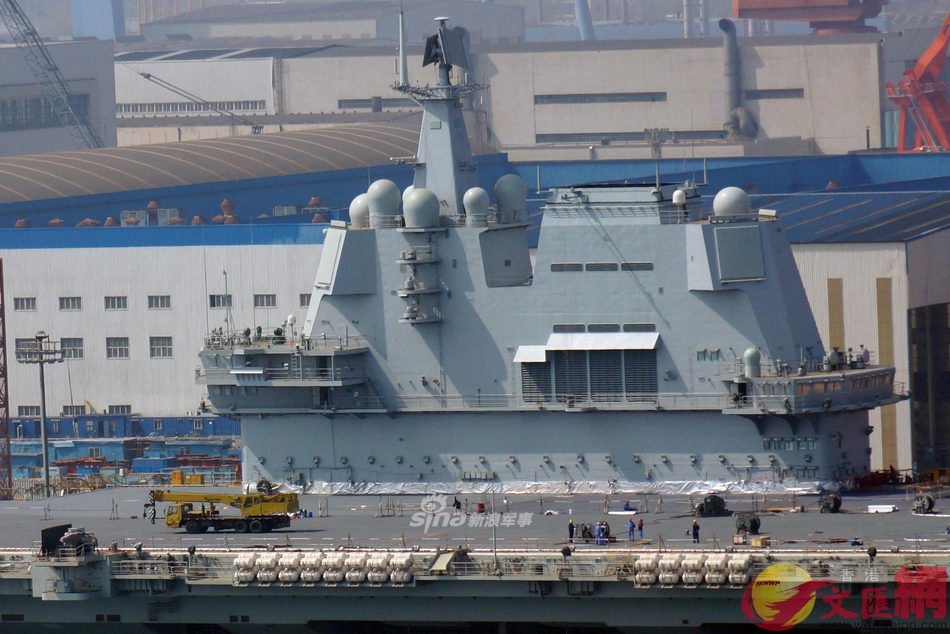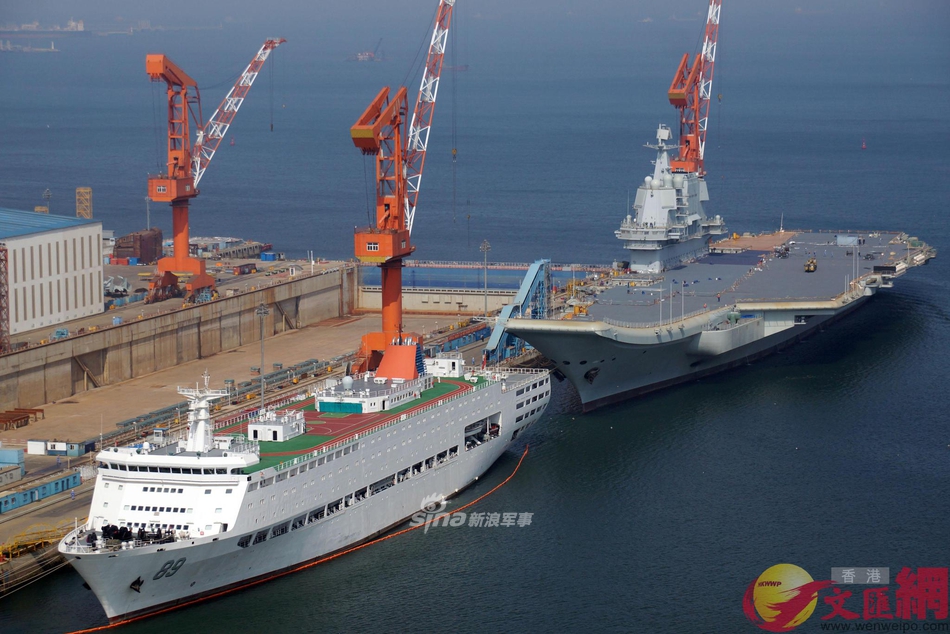Could they slow the elevator for the civilian visitors? Filled with large crowd of untrained and likely less cautioned civilians on a unsealed elevator, not much protection from falling the edge, and they seem don't even wear life jackets. And with such a huge piece of moving mechanical device they might want to take consideration of some visitor doing stupid things (as happened quite often). So maybe just slow down for safety.
You are using an out of date browser. It may not display this or other websites correctly.
You should upgrade or use an alternative browser.
You should upgrade or use an alternative browser.
CV-17 Shandong (002 carrier) Thread I ...News, Views and operations
- Thread starter Jeff Head
- Start date
- Status
- Not open for further replies.
asif iqbal
Banned Idiot
Yes I think it was slowed
Doubt they would be slamming the elevator up and down full blast with kids on board
Doubt they would be slamming the elevator up and down full blast with kids on board
I agree with you. But apparently, US Nimitz does not have the same conception of security. Or perhaps they accelerated the tape...Yes I think it was slowed
Doubt they would be slamming the elevator up and down full blast with kids on board
On the Nimitz, Kitty Hawk and even on the intrepid videos they use the lifts with retired persons, kids, pregnant women and so on, and with the same speed like on the Nimitz videos.Yes I think it was slowed
Doubt they would be slamming the elevator up and down full blast with kids on board
I am not so sure if the lift can be used in different speed settings, that require complicated mechanism that has no practical use.
I think the soviet designers of the ship left small space and weight allowance for the lift and its moving mechanism, so there is no way to speed it up.
Of course it still can be different speed setting, but even with the Nimitz speed it take 40 minutes to move out every planes from the hangar, due to small lift size and number.
Hendrik_2000
Lieutenant General
On the Nimitz, Kitty Hawk and even on the intrepid videos they use the lifts with retired persons, kids, pregnant women and so on, and with the same speed like on the Nimitz videos.
I am not so sure if the lift can be used in different speed settings, that require complicated mechanism that has no practical use.
I think the soviet designers of the ship left small space and weight allowance for the lift and its moving mechanism, so there is no way to speed it up.
Of course it still can be different speed setting, but even with the Nimitz speed it take 40 minutes to move out every planes from the hangar, due to small lift size and number.
There is such thing as variable speed control It was novelty in 60's But now they come down in price and you can get it for motor of all sizes from small to 15000HP. And China is the biggest producer of Motor and motor control and exported zillion of them world wide
Leading Marketplace for Industrial Motors, AC & DC - Used, Rebuilt and Surplus. Search Surplus Record. Surplus Machy. Directory. Surplus Equip. Directory. Serv Industry Since 1924. Types: G.E.,Westinghouse, Teco, Siemens, U.S.,Toshiba, Allis-Chalmers, Baldor.
Here is intro
Variable Frequency Drives
Basics
The Variable Frequency Drive is a particular kind of adjustable-speed drive that is used to control the speed of an AC motor. In order to control the motor's rotational speed, a Variable Frequency Drive controls the frequency of the electrical power supplied to it. Adding a Variable Frequency Drive to an application allows the motor speed to be adjusted in accordance with the motor's load, ultimately saving energy. Commonly used in a myriad of applications, a Variable Frequency Drive can be found operating ventilation systems, pumps, conveyors and machine tool drives.
How a Variable Frequency Drive Works
When complete voltage is applied to an AC motor, it accelerates the load and drops torque initially, keeping current especially high until the motor reaches full speed. A Variable Frequency Drive operates differently; it eliminates excessive current, increasing voltage and frequency in a controlled manner as the motor starts. This allows the AC motor to generate up to 150% of its rated torque, which could potentially be generated from the beginning, all the way up to full speed, without wasting energy. A Variable Frequency Drive converts power through three different stages. First, AC power is converted to DC power, followed by the switching on and off of the power transistors, causing a voltage waveform at the desired frequency. This waveform then adjusts output voltage according to the preferred designated value.
Physical Properties
Typically, a Variable Frequency Drive system involves an AC motor, controller, and operator interface. The three-phase induction motor is most commonly applied to a Variable Frequency Drive because it offers versatility and cost-effectiveness in comparison to a single-phase or synchronous motor. Though they can be advantageous in some circumstances, a Variable Frequency Drive system often utilizes motors that are designed for fixed-speed operation.
Variable Frequency Drive operator interfaces allow for the user to adjust operating speed, and start and stop the motor. The operator interface might also allow the user to switch and reverse between automatic control, or manual speed adjustment.
Advantages of a Variable Frequency Drive
- Process temperature can be controlled without a separate controller
- Low maintenance
- Longer lifespan for the AC motor and other machinery
- Lower operating costs
- Equipment in the system that cannot handle excessive torque is protected
Types of Variable Frequency Drives
There are three common Variable Frequency Drives (VFDs) that offer both advantages and disadvantages depending on the application they are used for. The three common VFD designs used include: Current Source Inverter (CSI), Voltage Source Inverter (VSI), and Pulse Width Modulation (PWM). However, there is a fourth type of VFD called Flux Vector Drive, which is emerging in popularity among end-users for its closed-loop control feature. Each VFD consists of a Converter, DC Link and Inverter section but how each one is constructed varies from drive to drive. Although the sections of each VFD are similar, they require a variation in circuitry in how they supply the frequency and voltage to the motor.
Current Source Inverter (CSI)
A Current Source Inverter (CSI) is a type of variable frequency drive (VFD) which converts incoming AC voltage and varies the frequency and voltage supplied to the AC Induction Motor. The general configuration of this type of VFD is like that of other VFDs in that it consists of a Converter, DC Link, and Inverter. The converter part of the CSI uses silicon-controlled rectifiers (SCRs), gate-commutated thyristors (GCTs) or symmetrical gate-commutated thyristors (SGCTs) to convert the incoming AC voltage to a variable DC voltage. In order to maintain the correct voltage to frequency (Volt/Hertz), the voltage must be regulated by the correct sequencing of the SCRs. The DC Link for this type of variable frequency drive uses an inductor to regulate the current ripple and to store the energy used by the motor. The inverter, which is responsible for converting the DC Voltage back to an AC sine-like waveform, comprises of SCRS, gate turn-off thyristors (GTOs) or symmetrical gate-commutated thyristors (SGCTs). These thyristors behave like switches which are turned on and off to create pulse width modulation (PWM) output that regulates the frequency and voltage to the motor. CSI variable frequency drives regulate current, require a large internal inductor and a motor load to operate. An important note about CSI VFD designs is the requirement of input and output filters which are necessary due to high harmonics in the power input and poor power factor. To work around this issue, many manufacturers implement either input transformers or reactors and harmonic filters at the point of common coupling (users electrical system connected to the drive) to help reduce the effects harmonics have on the drive system. Of the common VFD drive systems, CSI VFDs are the only type of drives that have regenerative power capability. Regenerative power capability means that power is driven back from the motor to the power supply can be absorbed.
Last edited:
Ahh guys.. I served aboard USS Nimitz in 1991. USS America in 1981. USS Hancock in 1975. USS Midway in '73 & '74. USS John F Kennedy in '72 & '73. The aircraft elevators aboard all USN CVNs have just one speed. That's all!!!... one!! Respotting/moving aircraft efficiently has more to do with well trained aircraft directors & aircraft handling crews than the speed of elevators...really.
ps sorry for thinking a J-15 was a J-10 ..I'm old doncha know
..I'm old doncha know ..
..
ps sorry for thinking a J-15 was a J-10
- Status
- Not open for further replies.






